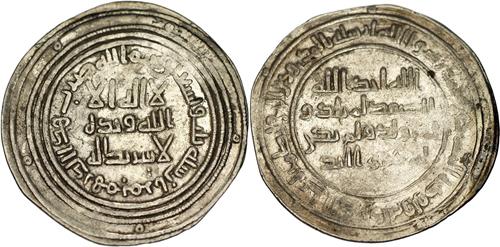
|
Umayyad Caliphate, Silver coinage. AR Dirham (27.9mm, 2.87 g, 8h). ‘Maziyan’ mint (uncertain location in Caucasian Albania). Dated AH 93 (AD 711/2). Good VF.
Islamic Auction 7 - Session One
Lot: 64. Estimated: $ 20 000
Umayyad Silver and Bronze, Silver
Sold For $ 15 500. This amount does not include the buyer’s fee.
Go to Live
|
|
Umayyad Caliphate, Silver coinage. AR Dirham (27.9mm, 2.87 g, 8h). ‘Maziyan’ mint (uncertain location in Caucasian Albania). Dated AH 93 (AD 711/2). Klat –; Al-‘Ajlan –. Good VF. Extremely rare, believed to be an unpublished date.
This is a new date for this enigmatic mint-name, which was previously only known for the year AH 92.
The reading ‘Maziyan’ is a conjectural one. The first letter of the mint-name is clearly ‘M’, and is connected to what can only be a ‘Z’ or ‘R’. This is followed by a single ‘tooth’ linked to an ‘A’, and then another isolated ‘tooth’. It has not been possible to construct a plausible version of the mint-name which can be matched to either ancient or modern geographical sources. There is a place called Marnab in present-day East Azerbaijan (Iran), but this is only a hamlet.
While the mint-name on this dirham cannot be read securely, let alone identified with a known town or city, it can nevertheless be attributed with confidence to a location in Caucasian Albania. This is because the distinctive calligraphy on dirhams from ‘Maziyan’, as well as the numerous points around the mint-name itself, are characteristic of a series of dirhams struck on the Northern frontier of the Umayyad lands. These coins have been studied in detail by Michael Bates (‘The Dirham Mint of the Northern Provinces of the Umayyad Caliphate,’ Armenian Numismatic Journal, XV (1989), pp.89-110). He argues convincingly that, while at least ten different Umayyad mint-names referring to locations in this area appear on the coinage, only one mint was normally active at any one time. He concludes that this was a mint which ‘moved from place to place as the governor moved his headquarters, taking the name at any time of the city of province where he was.’ (op. cit., p.91). Thus when two different mint-names are known for a particular date, this shows that the governor himself had moved from one location to another during that year.
Bates produced a table listing the sequence of dirham mints active in the region during the Umayyad period, which can now be supplemented by a few more recent discoveries. Dirhams with the mysterious mint-name ‘Maziyan’ are known for AH 92 and 93, for which we also have stylisticaly similar coins from the mints of Janza (AH 92) and Barda‘a (AH 92 and 93). These two cities, both located in present-day Azerbaijan (ancient Caucasian Albania), are barely fifty miles apart and so ‘Maziyan’ can be assigned with confidence to a location in the same area (so Bates, op cit., p. 103).
Closing Date and Time: at 14:21:00 ET.
|
